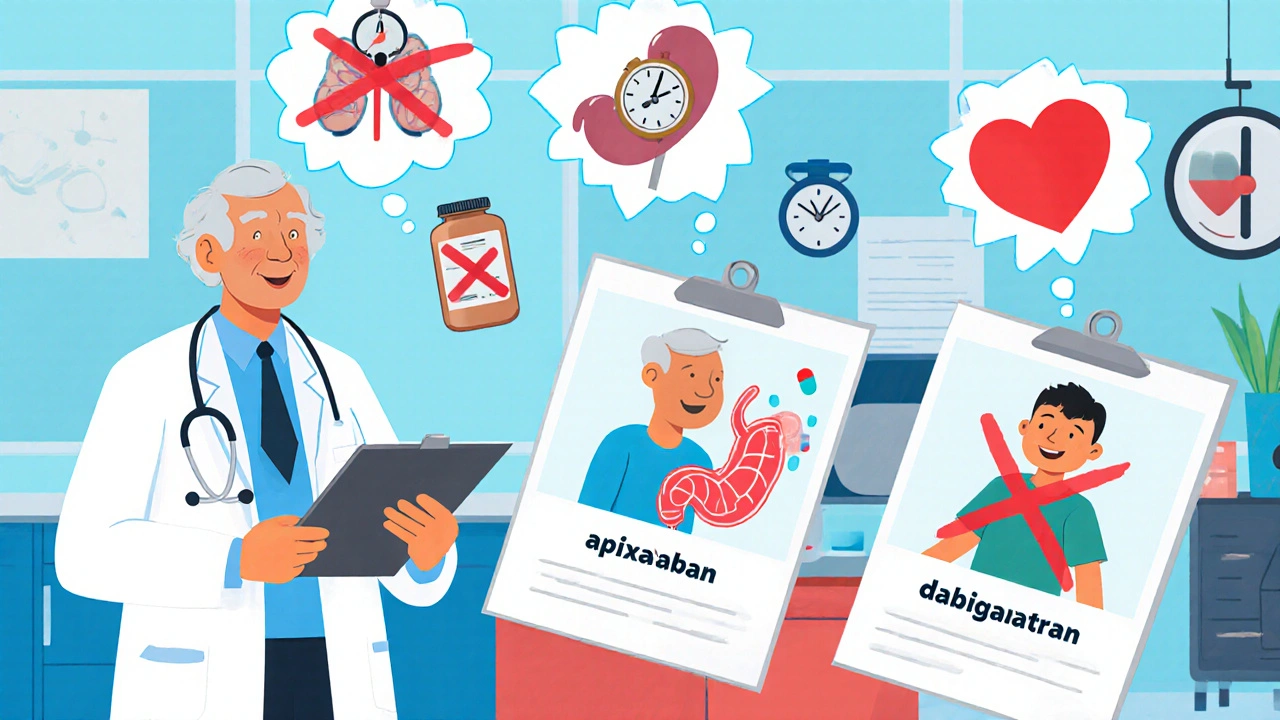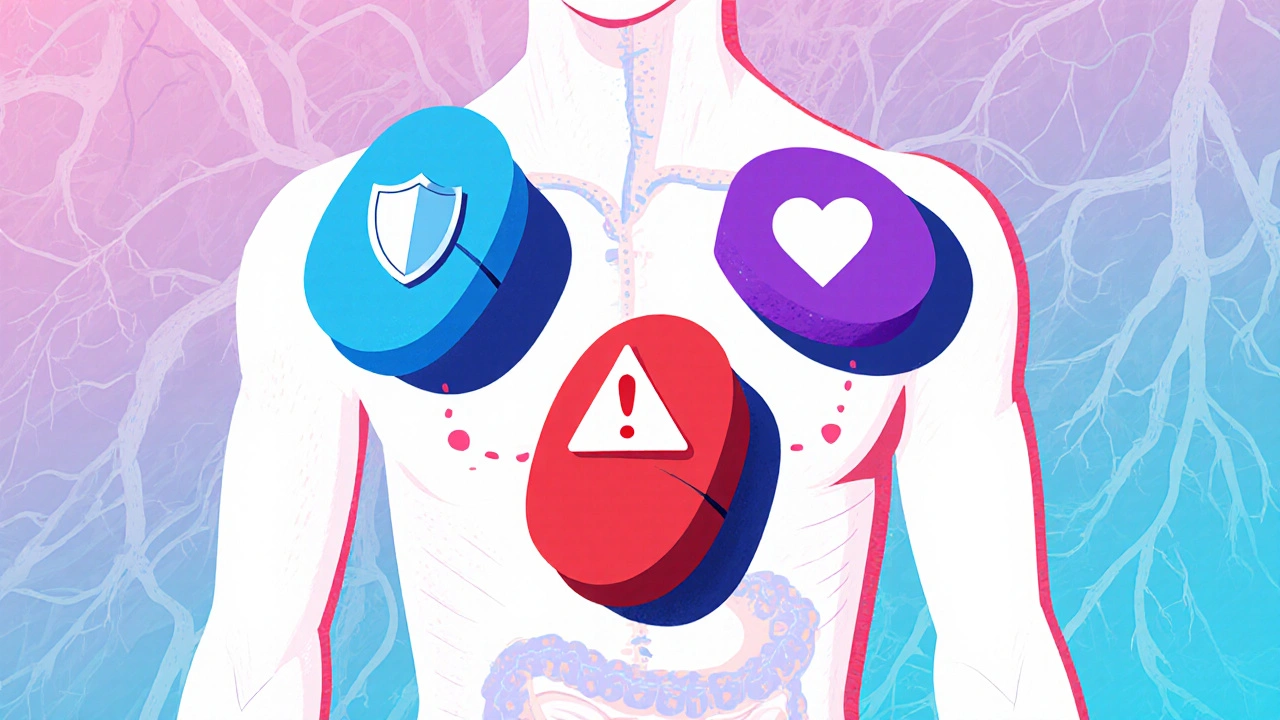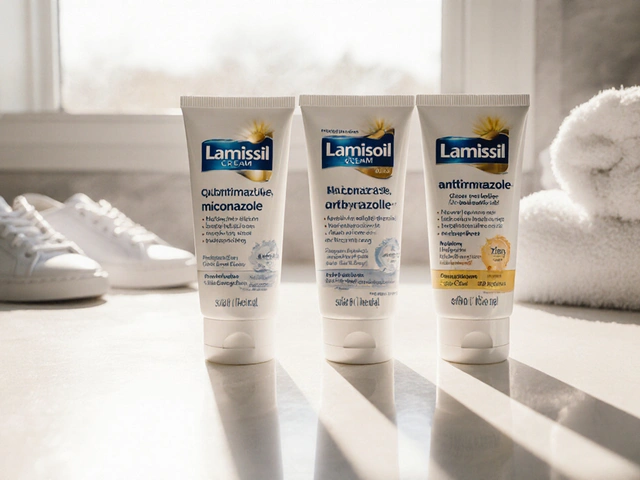DOAC Safety Risk Calculator
Your Personalized Safety Assessment
Enter your health factors to see which DOAC might be safest for you based on bleeding risks and side effects
Personalized Recommendation
Risk Comparison
Key Considerations
When you're on a blood thinner, you don't just want it to work-you want to know what else it might do to your body. Apixaban, rivaroxaban, and dabigatran are all direct oral anticoagulants (DOACs), designed to prevent clots without the constant blood tests that warfarin needs. But they're not the same. One might be easier on your stomach. Another might carry a higher risk of brain bleeding. And one could quietly raise your chance of a heart attack. Choosing the right one isn't about which is "best"-it's about which fits you.
How These Blood Thinners Work (And Why It Matters)
All three drugs stop blood from clotting too much, but they do it in different ways. Dabigatran blocks thrombin, the final enzyme that turns fibrinogen into clots. Apixaban and rivaroxaban both block factor Xa, an earlier step in the clotting chain. That might sound like a small difference, but it changes how they behave in your body-and what side effects you’re likely to get.Apixaban and rivaroxaban are both factor Xa inhibitors, but they bind differently. That’s why apixaban tends to be gentler on your gut. Dabigatran, the oldest of the three, has to be taken twice a day, no matter what. Rivaroxaban can be once daily for stroke prevention, which sounds convenient-but that convenience comes with trade-offs.
Gastrointestinal Bleeding: The Biggest Difference
If you’ve ever had a stomach ulcer, take NSAIDs like ibuprofen regularly, or are over 70, this matters a lot. Gastrointestinal bleeding is the most common serious side effect among DOACs-and it’s not evenly spread.Studies show apixaban has the lowest risk. One JAMA study found rivaroxaban caused nearly twice as many GI bleeds as apixaban: 35.2 events per 1,000 people per year versus 16.3. Dabigatran wasn’t far behind rivaroxaban. Another study in the Annals of Internal Medicine confirmed apixaban was 28% less likely to cause GI bleeding than rivaroxaban, even in patients over 80 or with kidney problems.
Why? It’s not fully understood, but apixaban’s lower concentration in the gut lining may be why. Rivaroxaban and dabigatran seem to irritate the stomach and intestines more. If you’ve had bleeding in your GI tract before, apixaban is often the first choice-not because it’s "safer overall," but because it’s safer for your stomach.
Major Bleeding: Where Rivaroxaban Falls Behind
Major bleeding means bleeding that requires hospitalization, transfusion, or causes a drop in hemoglobin. It’s rare, but when it happens, it’s serious.Rivaroxaban consistently shows higher rates. The same JAMA study found 39.7 major extracranial bleeds per 1,000 person-years with rivaroxaban. For apixaban? Just 18.5. That’s more than a 20-point difference. Dabigatran sat in the middle. Even when adjusted for age, kidney function, and other risk factors, rivaroxaban still carried a 2.07 times higher risk than apixaban.
This isn’t just about numbers. In real life, that means someone on rivaroxaban is more likely to end up in the ER with a swollen leg, vomiting blood, or unexplained bruising. For older adults or those with fragile blood vessels, that risk adds up.
Intracranial Hemorrhage: The Brain Bleed Factor
All three DOACs are better than warfarin at preventing brain bleeds. But here’s where things get surprising.One 2022 study found rivaroxaban had a lower rate of intracranial hemorrhage than apixaban. That contradicts what many doctors assumed-that all factor Xa inhibitors were equal here. Dabigatran, especially at the lower 110 mg dose, also showed strong protection against brain bleeds, with one study showing 54% fewer events than rivaroxaban.
This doesn’t mean you should pick rivaroxaban for brain safety. The overall bleeding risk is still higher. But it does mean we can’t assume all DOACs behave the same in every way. If someone has a history of falls or severe hypertension, the brain bleed risk becomes a bigger concern. And the data isn’t black and white.

The Hidden Risk: Heart Attacks and Coronary Events
This is the one most people don’t talk about. Dabigatran has been linked to a higher risk of heart attacks and acute coronary syndrome (ACS). Multiple meta-analyses, including one from the Journal of the American College of Cardiology, found a 48% relative increase in heart attacks with dabigatran compared to other DOACs.Why? Researchers think it might be because dabigatran’s direct thrombin inhibition triggers inflammation in artery walls-similar to a drug called ximelagatran that was pulled from the market for causing liver damage and heart attacks. It’s not proven, but the pattern is consistent across studies.
If you have coronary artery disease, a history of heart attack, or unstable angina, dabigatran may not be the best fit. Apixaban and rivaroxaban don’t show this same signal. For someone with atrial fibrillation and no heart disease, the risk is low. But for someone with a history of blocked arteries? That’s a red flag.
Renal Clearance: What Your Kidneys Tell You
Your kidneys clear these drugs from your body. But they don’t do it equally.Dabigatran is 80% cleared by the kidneys. Apixaban? Only 25%. Rivaroxaban is about 33%. That means if your kidney function drops-say, from a recent infection, dehydration, or aging-dabigatran builds up faster. That raises bleeding risk.
Guidelines say dabigatran shouldn’t be used if your creatinine clearance is below 30 mL/min (for the 150 mg dose). Apixaban and rivaroxaban can go lower-to 15 mL/min. That makes apixaban the go-to for older patients or those with mild-to-moderate kidney disease. You can still use dabigatran in kidney issues, but you need to reduce the dose, monitor closely, and avoid other kidney-stressing meds like NSAIDs.
Dosing and Daily Life
Rivaroxaban’s once-daily dose is tempting. It’s easier to remember. But that convenience comes with a cost: higher GI bleeding risk. Apixaban is always twice daily. Dabigatran is also twice daily, but it doesn’t need to be taken with food. Rivaroxaban does-for the stroke prevention dose, it’s best with your evening meal.For someone who forgets pills, a once-daily option might help adherence. But if you’ve had GI bleeding before, even perfect adherence won’t help if the drug itself is more likely to cause the problem. Sometimes, the right pill is the one you take consistently-but also the one that won’t hurt you.
What Do Real Doctors Recommend?
The American College of Cardiology’s 2022 guidelines say: if you’re at high risk for GI bleeding, choose apixaban. The European Heart Journal editorial board echoed this, saying doctors should stop treating all DOACs as interchangeable.Dr. Gregory Y.H. Lip, a leading expert in anticoagulation, says: "The differential bleeding risks should inform clinical decision-making." That’s not just a fancy phrase. It means your doctor should ask: Have you had ulcers? Are you on aspirin? Do you have kidney trouble? Are you over 75? Then pick accordingly.
Apixaban isn’t perfect. It’s more expensive than generic rivaroxaban (though generics have dropped prices significantly). But in real-world use, it’s become the most prescribed DOAC in the U.S.-not because of marketing, but because doctors are seeing fewer complications.
What About Cost?
Brand-name Eliquis (apixaban) costs around $518 for 60 tablets. But generic apixaban? You can get it for under $30 a month with GoodRx or similar programs. Rivaroxaban generics are even cheaper. Dabigatran is the most expensive of the three, and its market share has dropped to under 10% in the U.S.-partly because of safety concerns and partly because it’s not as cost-effective when you factor in hospital visits for bleeding.Cost matters. But if you end up in the ER because of a GI bleed, the hospital bill will dwarf the cost of the pill. Choosing the right drug isn’t just about the price tag-it’s about the total cost of care.
Final Takeaways: Who Gets Which Drug?
- Choose apixaban if: You’ve had GI bleeding, are over 75, have kidney issues, take NSAIDs, or want the lowest overall bleeding risk. It’s the safest bet for most people.
- Consider rivaroxaban if: You struggle with twice-daily dosing, have no history of stomach problems, and your doctor believes the once-daily convenience outweighs the higher bleeding risk. Avoid if you have active ulcers or severe kidney disease.
- Avoid dabigatran if: You have heart disease, a history of heart attack, or unstable angina. Also avoid if your kidneys are weak. It’s still an option for younger, healthy patients with no cardiac history-but it’s no longer first-line.
There’s no one-size-fits-all. The right blood thinner is the one that prevents clots without causing more harm. Talk to your doctor. Bring this data. Ask: "Which of these drugs is least likely to hurt me, given my history?"
Which blood thinner has the least side effects?
Apixaban generally has the lowest risk of serious side effects, especially gastrointestinal bleeding and major bleeding events. It’s also safer for people with kidney problems and older adults. While no drug is side-effect-free, apixaban has the most favorable safety profile across multiple large studies.
Can I switch from rivaroxaban to apixaban?
Yes, switching is common and often recommended if you’ve had bleeding, are over 75, or have kidney issues. Your doctor will typically stop rivaroxaban and start apixaban the next day, with no overlap. No bridging with heparin is needed. Always consult your provider before switching-never change on your own.
Does dabigatran cause heart attacks?
Multiple studies show dabigatran is linked to a higher risk of heart attacks and acute coronary syndrome compared to apixaban and rivaroxaban. The exact reason isn’t clear, but it may be due to how it affects inflammation in blood vessels. If you have heart disease, dabigatran is usually avoided.
Why is apixaban more expensive than rivaroxaban?
Brand-name apixaban (Eliquis) used to cost more, but generic versions are now widely available and cost as little as $10-$30 per month with coupons. Rivaroxaban generics are often slightly cheaper, but the cost difference is minimal compared to the potential savings from avoiding hospitalizations due to bleeding.
Which DOAC is safest for elderly patients?
Apixaban is the safest choice for elderly patients, especially those over 80. Studies show it has significantly lower rates of GI and major bleeding compared to rivaroxaban and dabigatran-even in frail, older adults with reduced kidney function. It’s now the preferred first-line DOAC for this group.






Dylan Kane
October 28, 2025 AT 13:29Apixaban for life. I’m 78, on it for AFib, and my GI tract hasn’t thrown a tantrum since switching from rivaroxaban. My doc said it’s the gold standard for older folks-and honestly, I’m not gonna risk another ER trip just to save a few bucks on pills.
Shanice Alethia
October 30, 2025 AT 13:10Y’all are acting like apixaban is some miracle drug. Dabigatran’s been stigmatized because Big Pharma doesn’t push it anymore, but if you’re young and healthy, it’s totally fine. And let’s not pretend rivaroxaban is a death sentence-my uncle’s been on it for 5 years with zero issues. Stop fearmongering and start thinking for yourselves.
Sam Tyler
October 31, 2025 AT 01:22It’s important to recognize that while apixaban has the best safety profile overall, the choice isn’t just about numbers-it’s about individual biology and lifestyle. For example, someone with erratic sleep patterns or a job that requires shift work might find twice-daily dosing impossible, even if it’s safer. Adherence is a silent killer in anticoagulation therapy. A drug that’s slightly riskier but taken consistently is often better than a perfect drug taken sporadically. Also, kidney function fluctuates-don’t just look at one creatinine clearance value from six months ago. Reassess regularly, especially after infections or dehydration. And for anyone considering switching: do it under supervision. There’s a window of vulnerability when you transition between DOACs, and skipping bridging isn’t always as safe as people think if renal function is borderline.
shridhar shanbhag
October 31, 2025 AT 09:56From India, we see a lot of patients on rivaroxaban because it’s cheaper and once-daily-but we also see more GI bleeds. My father had a gastric ulcer after 8 months on it. Switched to apixaban and no issues since. But here’s the thing: in rural areas, people forget meds anyway. So sometimes, even with higher risk, the once-daily option gets taken more often. It’s a trade-off between safety and reality.
John Dumproff
October 31, 2025 AT 20:34I love how this thread is turning into a real-life clinical discussion. It’s not just about which drug is ‘best’-it’s about who you are. I’m a nurse and I’ve seen patients cry because they thought they were failing by needing to take pills twice a day. But if apixaban means they don’t end up in the ICU bleeding out? That’s not a burden-it’s a gift. Please stop shaming people for choosing safety over convenience. Your body isn’t a spreadsheet.
Lugene Blair
November 2, 2025 AT 15:57Wait-so dabigatran raises heart attack risk? That’s wild. I’m on it for AFib and have a family history of CAD. I’m switching to apixaban tomorrow. Thanks for the heads-up, this post literally saved me from a potential disaster.
William Cuthbertson
November 3, 2025 AT 02:08There’s a deeper cultural layer here. In the U.S., we treat medications like consumer products-pick the cheapest, the easiest, the most advertised. But anticoagulation isn’t a subscription service. It’s a lifelong negotiation with your own biology. In the UK, we’re taught to see these drugs as tools, not trophies. Apixaban isn’t ‘better’ because it’s marketed well-it’s better because the data doesn’t lie. And yet, we still let cost and convenience dictate life-or-death decisions. That’s not medicine. That’s capitalism masquerading as care.
Eben Neppie
November 4, 2025 AT 01:45Shanice, your comment is dangerously naive. Dabigatran’s link to myocardial infarction isn’t anecdotal-it’s replicated across 12+ meta-analyses. Rivaroxaban’s GI bleeding risk is statistically significant in patients over 65. Apixaban’s superiority isn’t opinion-it’s Level 1 evidence. If you’re dismissing this because of convenience, you’re not being bold-you’re being reckless. And if you’re a patient reading this? Don’t listen to people who treat anticoagulation like a TikTok trend. Talk to your hematologist. Bring this post. Ask for the trial data. Your life isn’t a debate forum.